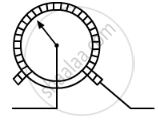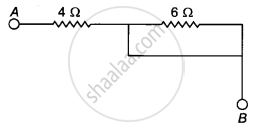Advertisements
Advertisements
Question
A copper wire has diameter 0.5 mm and resistivity of 1.6 × 10−8Ω m. What will be the length of this wire to make its resistance 10 Ω? How much does the resistance change if the diameter is doubled?
Solution
Given diameter of the wire,
D = 0.5 × 10−3 m
resistivity of copper, ρ = 1.6 x 10−8 ohm m required resistance, R = 10 ohm
As R = `(ρl)/A, l = (RA)/ρ = (R((piD^2)/4))/ρ = (πRD^2)/(4ρ)` ...`[∵ A = pir^2 = pi(D/2)^2 = (piD^2)/4]`
∴ `l = (3.14 xx 10 xx (0.5 xx 10^-3)^2)/(4 xx 1.6 xx 10^-8)`
m = 122.7 m
Since `R = (ρl)/((πD^2)/4)`
= `(4ρl)/(πD^2), R∝1/D^2`.
When D is doubled, R becomes `1/4` times.
APPEARS IN
RELATED QUESTIONS
Two conducting wires of the same material and of equal lengths and equal diameters are first connected in series and then parallel in a circuit across the same potential difference. The ratio of heat produced in series and parallel combinations would be:
Why are copper and aluminium wires usually employed for electricity transmission?
List the factors on which the resistance of a conductor in the shape of a wire depends.
Why are alloys commonly used in electrical heating devices? Give reason.
Fill in the following blanks with suitable words:
Copper is a good .......... Plastic is an ..........
What is the general name of the substances having infinitely high electrical resistance?
What happens to the resistance as the conductor is made thinner?
How does the resistance of a conductor depend on:
length of the conductor?
What would be the effect on the resistance of a metal wire of:
increasing its length?
How does the resistance of a wire change when:
its material is changed to one whose resistivity is three times?
Calculate the area of cross-section of a wire if its length is 1.0 m, its resistance is 23 Ω and the resistivity of the material of the wire is 1.84 × 10−6 Ω m.
The figure blow shows a variable resistor in a dimmer switch.

How would you turn the switch to make the lights: (a) brighter, and (b) dimmer? Explain your answer.
Write the relation between resistance and electrical resistivity of the material of a conductor in the shape of a cylinder of length `'l'` and area of cross-section `'A'` . Hence derive the S.I. unit of electrical resistivity.
How will you infer with the help of an experiment that the same current flows through every part of the circuit containing three resistors R1, R2 and R3 in series connected to a battery of V volts?
Materials which allow larger currents to flow through them are called:
The effective resistance between A and B is:

A cylindrical conductor of length l and uniform area of cross-section A has resistance R. Another conductor of length 2l and resistance R of the same material has an area of cross-section:
How will you infer with the help of an experiment that the same current flows through every part of the circuit containing three resistances in series connected to a battery?
How will the resistance of a wire be affected if its
- length is doubled, and
- radius is also doubled ?
Give justification for your answer.
